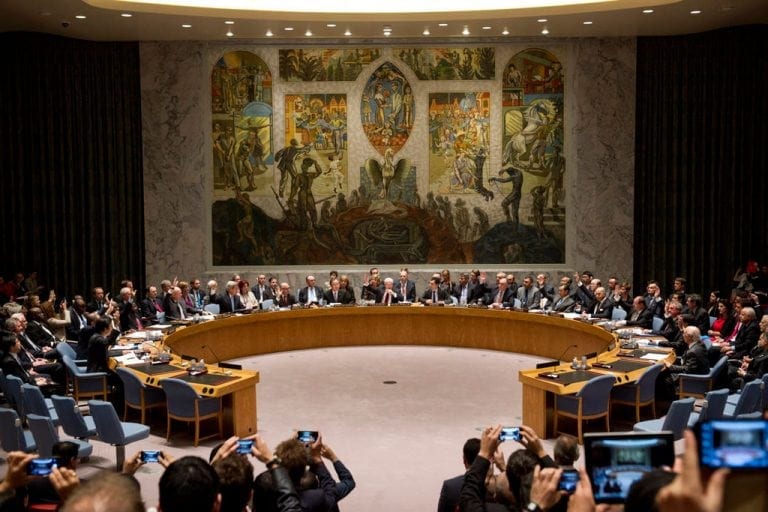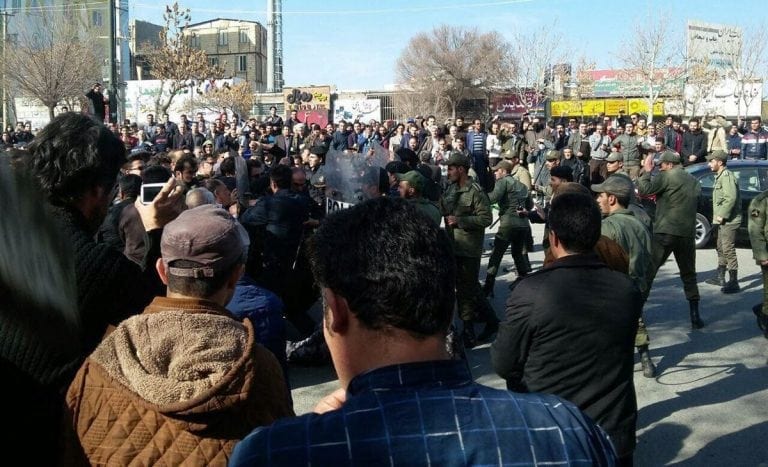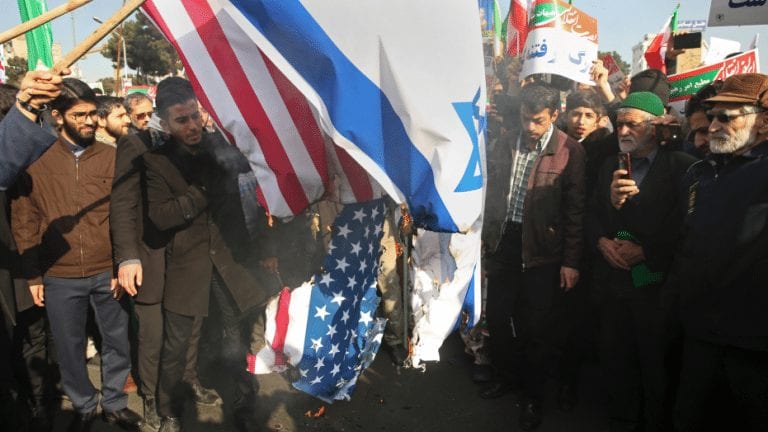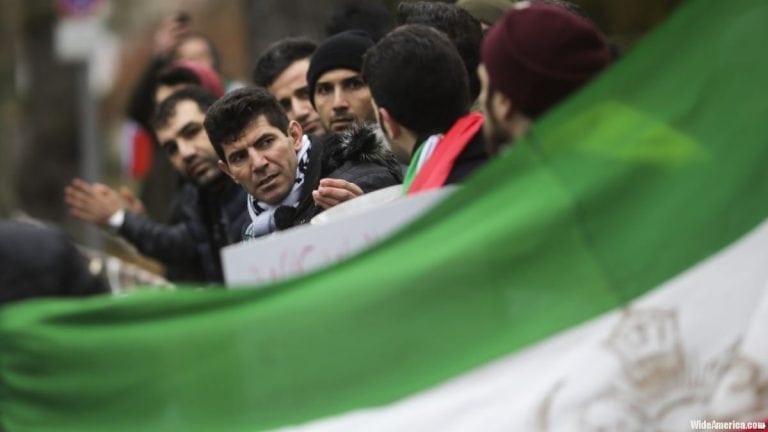As the new year begins, it is important for the U.S. to acknowledge its troubling history of global war-making, especially over the past two-decades, as Nicolas J.S. Davies delineates.

Imperial muscle on display. A US Navy carrier battle formation in the Pacific. We have never quite abandoned gun boat diplomacy, only made our ships much bigger. Aggression and intimidation remains the backbone of our foreign policy.
I met John Lennon and Yoko Ono on Christmas Eve in 1969. I joined them and a small group of local peace activists in a Christmas fast for world peace in front of Rochester Cathedral in England, a short walk from where I lived with my family in Chatham Dockyard. I was 15 years old, and my father was the dockyard medical officer, responsible for the health and safety of the dockyard workers who maintained the U.K.’s new fleet of nuclear submarines.
John and Yoko arrived before midnight mass. We were all introduced and went in for the service. By the time we came out, thousands of people had heard John was there. He was still a Beatle and he was mobbed by a huge crowd, so he and Yoko decided they couldn’t stay with us as planned. While most of our little group helped John back to their iconic white Rolls Royce, I and another boy not much older than me were left to shepherd a panicking Yoko back through the crowd to the car. They both made it, and we never saw them again. The next morning a florist came by with a huge box of white carnations, and we spent the rest of our Christmas and Boxing Day handing flowers to passers-by and getting to know each other – the birth of what became the Medway and Maidstone Peace Action Group.
While the U.K. was not openly involved in the Vietnam War, it was deeply involved in the Cold War and the nuclear arms race, and watching the U.K.’s closest ally destroy Vietnam led many of my generation to question the Cold War assumptions about “good guys” and “bad guys” that we’d been raised on. John and Yoko became the de facto leaders of the peace movement, and their song “Give Peace a Chance” was a simple unifying anthem.
After two world wars, Korea, Vietnam and the Cold War, we all wanted peace, but it seemed to be the one thing our leaders were not willing to try, claiming that the Cold War justified an endless arms race, and wars and coups wherever U.S. and British leaders thought they’d spotted a Red under somebody’s bed. That included many countries whose experiments with socialism were less advanced than in the U.K., where I grew up with a cradle to grave healthcare system, free education through university, a comprehensive welfare state and state-owned utilities, railways and major industries.
The peace dividend vs the power dividend
[dropcap]O[/dropcap]nce the Cold War ended, the justification for 50 years of massive military spending, global warfare and coups was finally over. Like U.S. allies, enemies and neighbors around the world, Americans breathed a sigh of relief and welcomed the “peace dividend.” Robert McNamara and Lawrence Korb, former cold warriors of both parties, testified to the Senate Budget Committee that the U.S. military budget could be cut in half from its FY1990 level over the next 10 years. Committee chairman Senator Jim Sasser hailed “this unique moment in history” as “the dawn of the primacy of domestic economics.”
But the peace dividend was short-lived, trumped by what Carl Conetta of the Project for Defense Alternatives has dubbed the “power dividend,” the drive to exploit the end of the Cold War to consolidate and expand U.S. military power. Influential voices linked to military industrial interests had a new refrain, essentially “Give War a Chance.” But of course, they didn’t put it so plainly:
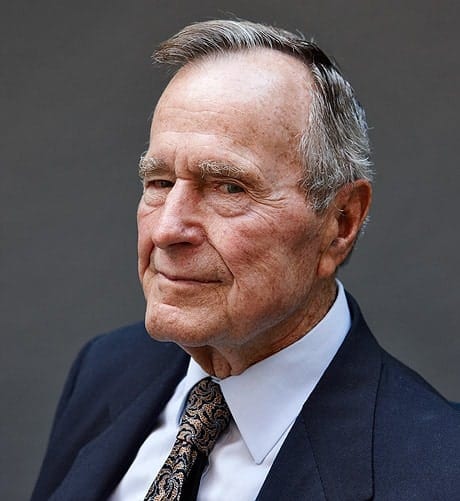
G H W Bush 41: only slightly less criminal than his son, and even more treacherous.
– After the First Gulf War in 1991, President Bush I celebrated “kick(ing) the Vietnam syndrome,” and deployed U.S. pilots directly from Kuwait to the Paris Air Show to cash in on the marketing value of a war that had just killed tens of thousands of people in Iraq. The next 3 years set a new record for U.S. arms sales. The Pentagon later admitted that only 7% of the bombs and missiles dropped on Iraq were the “precision-guided” ones they showcased to TV viewers, and only 41% to 60% of those “precision” weapons hit their targets anyway. Iraq was ruthlessly carpet bombed, but we were sold a high-tech dog and pony show.
– Despite surely being well aware of the reality behind the propaganda, Undersecretary of Defense Paul Wolfowitz crowed to General Wesley Clark, “With the end of the Cold War, we can now use our military with impunity.”
– As the Clinton administration took over the reins of the U.S. war machine in 1992, Madeleine Albright challenged General Colin Powell on his “Powell Doctrine” of limited war, asking him, “What’s the point of having this superb military you’re always talking about if we can’t use it?”
– Albright was appointed Secretary of State in 1997, mainstreaming new political pretexts for otherwise illegal wars such as “humanitarian intervention” and the “responsibility to protect.” But despite the steady diet of war propaganda, Albright was drowned out by protests from the audience when she threatened war on Iraq at a town hall meeting in Columbus in 1998.
– Clinton’s 1997 Quadrennial Defense Review declared, “When the interests at stake are vital… we should do whatever it takes to defend them, including, when necessary, the unilateral use of military power. U.S. vital national interests include, but are not limited to… preventing the emergence of a hostile regional coalition… (and) ensuring uninhibited access to key markets, energy supplies and strategic resources.” But as the U.K. Foreign Office’s senior legal adviser told his government during the Suez crisis in 1956, “The plea of vital interest, which has been one of the main justifications for wars in the past, is indeed the very one which the UN Charter was intended to exclude as a basis for armed intervention in another country.”
– After a failed CIA coup in 1996 betrayed every CIA agent in Iraq to the Iraqi government, precluding a second coup attempt, the newly formed neoconservative Project for the New American Century began pushing for war on Iraq. The 1998 Iraq Liberation Act, threatening “regime change” through the use of military force, passed Congress with only 38 Nays in the House and unanimous consent in the Senate.
– When U.K. Foreign Secretary Robin Cook told Albright his government was having trouble “with our lawyers” over NATO’s illegal plan to attack Yugoslavia and annex Kosovo, she told him it should just “get new lawyers.”
– Speaking at the Council on Foreign Relations a few weeks before being elected to the U.S. Senate in 2000, Hillary Clinton derided recent U.S. wars in Panama, Kuwait and Yugoslavia as “splendid little wars” and called for what a banking executive in the audience described as a “new imperialism.”
– Samantha Power popularized the idea that the use of U.S. military force could have prevented the genocide in Rwanda, an assumption challenged by experts on genocide (see “A Solution From Hell”) but which has served ever since as a powerful political argument for the U.S. uses of military force.
Afghanistan
[dropcap]A[/dropcap]fter pleading with the American people to “Give War a Chance” for a decade, U.S. political leaders seized on the crimes of September 11th, 2001 to justify an open-ended “global war on terror.”
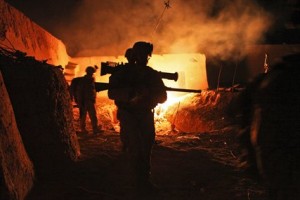
U.S. Marines leaving a compound at night in Afghanistan’s Helmand province. (Defense Department photo)
Many Americans approved of attacking Afghanistan as an act of self defense, but of course it was not Afghanistan or the Taliban that committed the crimes of September 11th. As former Nuremberg prosecutor Ben Ferencz told NPR at the time, “It is never a legitimate response to punish people who are not responsible for the wrong done. If you simply retaliate en masse by bombing Afghanistan, let us say, or the Taliban, you will kill many people who don’t approve of what has happened.”
Sixteen years later, 16,500 U.S. troops soldier on through the graveyard of empires, while U.S. warplanes have dropped 3,852 bombs and missiles on Afghanistan since Mr. Trump took office. No serious study has been conducted to estimate how many hundreds of thousands of Afghans have been killed since 2001.
As Matthew Hoh wrote in his resignation letter as he quit his post as the U.S. Political Officer in Zabul Province in Afghanistan in 2009,
“The Pashtun insurgency, which is composed of multiple, seemingly infinite local groups, is fed by what is perceived by the Pashtun people as a continued and sustained assault, going back centuries, on Pashtun land, culture, traditions and religion by internal and external enemies. …I have observed that the bulk of the insurgency fights not for the white banner of the Taliban, but rather against the presence of foreign soldiers and taxes imposed by an unrepresentative government in Kabul.”
Or as an Afghan taxi driver in Vancouver told me, “We defeated the Persians in the 18th century, the British in the 19th century and the Russians in the 20th. Now, with NATO, we’re fighting 29 countries at once, but we’ll defeat them too.” Who would doubt it?
Today, after 16 years of occupation by up to 100,000 U.S. troops, thousands of deadly “kill or capture” night raids by U.S. special operations forces and over 60,000 bombs and missiles dropped on Afghanistan on the orders of 3 U.S. presidents, the corrupt U.S.-backed government in Kabul governs less territory today than at any time since before the U.S. invasion.
The U.S. war on Afghanistan is the longest war in U.S. history. There must be U.S. troops in Afghanistan today whose fathers were fighting there 16 years ago. This isn’t giving war a chance. It’s giving it a blank check, in blood and money.
Iraq
[dropcap]W[/dropcap]hen President Bush II unveiled a “national security strategy” based on a flagrantly illegal doctrine of preemptive war in 2002, Senator Edward Kennedy called it a “call for 21st century imperialism that no other country can or should accept.” The rest of the world rejected the U.S. case for war on Iraq in the UN Security Council and 30 million people took to the streets in the largest global demonstrations in history. But the U.S. and U.K. invaded Iraq anyway.
The U.K.’s role in the invasion was thrown into limbo when Admiral Michael Boyce, the Chief of the Defense Staff, told his government he could not give orders to invade Iraq without written confirmation that it would be legal. It took Tony Blair and his cronies five full days of grappling with their legal advisers before one of them, Attorney General Peter Goldsmith, who was not even an international lawyer, was willing to contradict what he and all the U.K.’s legal advisers had consistently and repeatedly told their government, that the invasion of Iraq would be a criminal act of aggression.
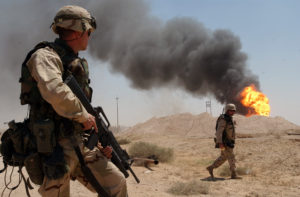
U.S. Army forces operating in southern Iraq during Operation Iraqi Freedom, Apr. 2, 2003 (U.S. Navy photo)
Four days later, the U.S. and U.K. committed the war crime of the new century, unleashing a war that has killed a million innocent people and left Iraq mired in bloody violence and chaos for 14 years and counting.
When the people of Iraq rose in resistance to the illegal invasion and occupation of their country, the U.S. launched a bloody “counterinsurgency” campaign. As U.S. forces destroyed Fallujah and Ramadi, U.S. officials in Baghdad recruited, trained and ran Interior Ministry death squads who tortured and assassinated tens of thousands of men and boys to ethnically cleanse Baghdad and other areas on a sectarian basis.
The most recent U.S. atrocity in Iraq was the massacre of an estimated 40,000 civilians in Mosul by U.S., Iraqi, French and other “coalition” forces. The U.S.-led bombing campaign in Iraq and Syria has dropped 104,000 bombs and missiles since 2014, making it the heaviest U.S. bombing campaign since the American War in Vietnam. Iraqi government death squads once again prowl through the ruins of Mosul, torturing and summarily executing anyone they identify as a suspected Islamic State fighter or sympathizer.
In Iraq, “Give war a chance” does not mean, “It didn’t work here. Let’s try it somewhere else.” It means, “Keep bombarding Fallujah, Ramadi and Mosul and massacring their people over and over again until there is nothing left but rubble and graveyards.” That is why 9,123 U.S. troops remain deployed in a land of rubble and graveyards in the 15th year of an illegal war.
Somalia
[dropcap]I[/dropcap]ndependent Somalia was formed from the former colonies of British and Italian Somaliland in 1970. After initially investing in literacy and infrastructure, Said Barre and his government built the largest army in Africa, supported first by the U.S.S.R. and then by the U.S., as it waged a long war with Ethiopia over the Ogaden, an ethnically Somali region of Ethiopia. In 1991, Barre was ousted in a civil war and the central government collapsed. UN and U.S. military interventions failed to restore any kind of order and foreign troops were withdrawn in 1995.
For the next 11 years, a dozen warlords ruled small fiefdoms while the Transitional Federal Government (TFG), the internationally recognized government, hunkered down in Baidoa, the sixth largest city. But the country was not as violent as some other parts of Africa. Somalia is an ancient society and some order was preserved by traditional systems of law and government, including a unique system of customary law called Xeer, which has existed and evolved in Somalia since the 7th century.
In 2006, these various local authorities came together and formed the Islamic Courts Union (ICU). With the support of one of the strongest warlords, they defeated other warlords, including ones backed by the CIA, in fierce fighting in the capital, Mogadishu, and soon controlled the southern half of the country. People who knew Somalia well hailed the ICU as a hopeful development and tried to reassure the Bush administration that it was not a danger.
But the threat of peace breaking out in Somalia was too much for the “give war a chance” crowd to stomach. The U.S. backed an Ethiopian invasion, supported by U.S. air strikes and special operations forces, plunging Somalia back into violence and chaos that continues to this day. The Ethiopian invaders drove the ICU out of Mogadishu, and it split into factions, with some of its leaders going into exile and others forming new armed groups, not least Al-Shabaab [an offshoot of Al Qaeda], to resist the Ethiopian invasion.
After Ethiopia agreed to withdraw its forces in 2008, a coalition government was formed by TFG and ICU leaders but did not include Al-Shabaab, which by then controlled large areas of the country. The government has been fighting Al-Shabaab ever since, supported by an African Union force and currently at least 289 U.S. special operations forces and other U.S. troops. The government has made gains, but Al-Shabaab still controls some areas. As it has been pushed back militarily, Al-Shabaab has launched devastating terrorist attacks in Somalia and Kenya, where the U.S. now also has 212 troops deployed. Neighboring Djibouti hosts 4,715 U.S. troops at the largest U.S. base in Africa.
The U.S. is doggedly expanding its militarized “counterterrorism” strategy in Africa, with at least 7,271 U.S. troops in 47 countries as of September 30th. But a new body of research has confirmed what independent analysts have long believed, that it is precisely these kind of operations that drive civilians into armed resistance in the first place. A recent survey of 500 African militants by the UN Development Program found that the “tipping-point” that decided 71% of them to join a group like Al-Shabaab, Boko Haram or Al Qaeda was the killing or detention of a family member or friend in U.S.-led or U.S.-model “counterterrorism” operations.
So the circular logic of U.S. counterterrorism policy uses the emergence and growth of groups like Al-Shabaab as a pretext to expand the operations that are fueling their growth in the first place, turning more and more civilians into combatants and their homes and communities into new U.S. battlefields, to “give war a chance” in country after country.
Honduras

Former Honduran President Manuel Zelaya.
[dropcap]O[/dropcap]n June 28th 2009, President Manuel Zelaya of Honduras was woken in the early hours of the morning by soldiers in combat gear bursting into his official residence. They hauled him away at gunpoint in his pajamas, bundled him into a car and onto a plane to Costa Rica. President Obama immediately called the coup a coup and reaffirmed that Zelaya was still the democratically-elected president of Honduras, appearing to adopt the same position as every government in Latin America, the European Union and the UN General Assembly.
But, in the coming days, as Hillary Clinton has since admitted, she went to work to push for a new election in Honduras that would, as she put it, “render the question of Zelaya moot,” by making the coup against him a fait accompli and allowing the coup regime of Roberto Micheletti to organize the new election.
Despite Obama’s statement and Wikileaks’ release of cables in which the U.S. Ambassador also called this an illegal coup, the U.S. never officially recognized that a coup had taken place, avoiding the cut-off of military aid to the post-coup government that was required under U.S. federal law and any further action to restore the democratically-elected president. In the coming years, Honduras, which was already the murder capital of the world, became even more dangerous as labor organizers and activists of all stripes were killed with impunity by the post-coup government’s death squads. Environmental activist Berta Cáceres’ murder caused worldwide outrage, but she is one of hundreds of activists and organizers killed.
The role of Secretary Clinton and the U.S. government in consolidating the results of the coup in Honduras should be seen in the context of the U.S.’s dominant historic role in Honduras, the original “banana republic,” 70% of whose exports are still sold to the United States. Honduras currently hosts 529 U.S. military personnel, far more than any other country in the Western hemisphere, and they are deeply embedded with the Honduran military which committed the coup.

John Negroponte, a diplomatic vulture well versed in the sordid arts of counter-revolution, mass assassinations, and organized sedition. An unindicted war criminal by any standard.
In the 1980s, under Ambassador John Negroponte, who eventually became Director of National Intelligence, the U.S. Embassy in Tegucigalpa reportedly hosted the largest CIA station in the world, from where the CIA ran its covert war against Nicaragua, death squads that killed even American nuns with impunity in El Salvador and an outright genocide in Guatemala. With this history of U.S. military and CIA involvement in Honduras, it is not unreasonable to suspect that the CIA was secretly involved in planning the coup against Zelaya.
The 2009 coup in Honduras has now come home to roost, as even the historically U.S.-controlled Organization of American States has demanded a rerun of the latest rigged election and Honduras’s feared Cobra paramilitary police have refused to repress pro-democracy protesters. The opposition party, the Opposition Alliance Against the Dictatorship, which appears to have won the most votes in the election, is a coalition of left and right against the post-coup government. How far will Trump and the U.S. go to rescue Clinton’s 2009 campaign in Honduras? Will it ask us to “give war another chance?”
Yemen
[dropcap]F[/dropcap]rom 897 (not a typo) until 1962, most of Yemen was ruled by the Zaidi Imams. The Zaidis follow a branch of Shiite Islam, but in Yemen they coexist and worship in the same mosques as Sunnis. The Houthis, who rule most of Yemen today, are also Zaidis. The last Zaidi Imam was overthrown by a republican coup in 1962, but, with Saudi support, he fought a civil war until 1970. Yes, you read that right. In the 1960s, the Saudis backed the Zaidi royalists in the Yemeni civil war. Now they call the Zaidis apostates and Iranian stooges and are waging a genocidal war to bomb and starve them to death.
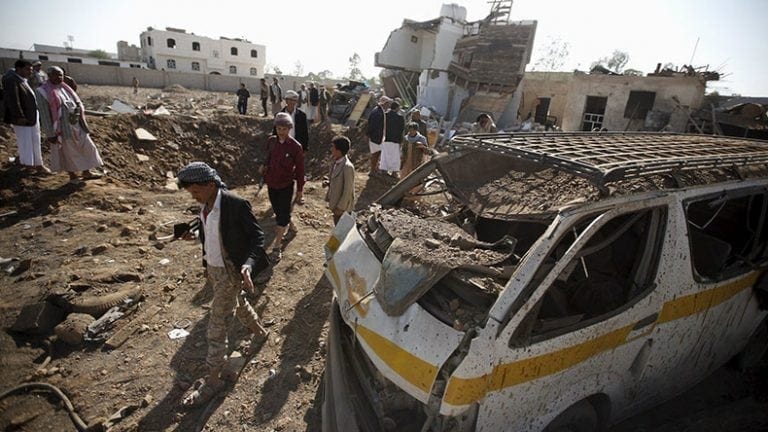
At the peak of the previous civil war, 70,000 Egyptian troops fought on the republican side in Yemen, but the 1967 Arab-Israeli War changed the priorities of Arab countries on both sides. In February 1968, royalist forces lifted their siege of Sana’a and the two sides began peace talks, which led to a peace agreement and international recognition of the Yemen Arab Republic in 1970.
Meanwhile, also in 1967, a popular armed rebellion forced the U.K. to withdraw from its colony in Aden, which formed the People’s Democratic Republic of Yemen, a Marxist state and Soviet ally. When the Cold War ended, the two Yemens merged to form a united Republic of Yemen in 1990. Ali Abdallah Saleh, the president of North Yemen since 1978, became president of the united Yemen and ruled until 2011.
Saleh’s repressive government alienated many sectors of Yemeni society, and the Zaidi Houthis launched an armed rebellion in their northern homeland in 2004. The Zaidis and other Shia Muslims make up about 45% of the population and Zaidis ruled the country for centuries, so they have always been a force to be reckoned with.
At the same time, the new Obama administration launched a campaign of cruise missile and drone strikes and special forces operations against the fledgling Al Qaeda faction in the country and increased military aid to Saleh’s government. A U.S. drone strike assassinated Yemeni-American preacher Anwar al-Awlaki, and another strike two weeks later murdered his American son, 16-year-old Abdulrahman. Like militarized U.S. counterterrorism campaigns in other countries, U.S. attacks have predictably killed hundreds of civilians, fueling the growth of Al Qaeda in Yemen.
Arab Spring protests and political turmoil forced Saleh to resign in November 2011. His deputy, Abdrabbuh Mansur Hadi, was elected in February 2012 to head a unity government that would draw up a new constitution and organize a new election in two years. After Hadi failed to hold an election or step down as president, the Houthis invaded the capital in September 2014, placed him under house arrest and demanded that he complete the political transition.
Hadi and his government rejected the Houthis’ demands and simply resigned in January 2015, so the Houthis formed a Revolutionary Council as an “interim authority.” Hadi fled to Aden, his hometown, and then to Saudi Arabia, which launched a savage bombing campaign and naval blockade against Yemen on Hadi’s behalf. The U.S. provides most of the weapons, munitions, satellite intelligence and in-air refueling and is a vital member of the Saudi-led coalition, but of course U.S. media and politicians downplay the U.S. role.
The Saudi-U.S. coalition’s bombing campaign has killed at least ten thousand civilians, probably many more, while a naval blockade and the bombing of ports have reduced the population to a state of near-starvation. Hadi’s forces have recaptured Aden and an area around it, but they have failed to defeat the Houthis in the rest of the country.
U.S.-made bombs keep hitting markets, hospitals and other civilian targets in Yemen. Western military trainers regard the Saudi armed forces as more or less untrainable, due mainly to Saudi Arabia’s rigid class and tribal hierarchy. The officer corps, some of whom are members of the royal family, are beyond criticism, so there is no way to correct mistakes or enforce discipline. So Saudi pilots bomb indiscriminately from high altitude, and will keep doing so unless and until the U.S. stops selling them munitions and withdraws its military and diplomatic complicity in this genocidal war.
Aid agencies keep warning that millions of Yemenis are close to starvation, but neither Saudi nor U.S. officials seem to care. The normalization of war and the culture of apathy nurtured by 16 years of American wars that have killed millions of people in a dozen countries have left U.S. officials supremely cynical, but their cynicism will be tested in 2018 as the predictable results of this “made in the U.S.A.” humanitarian catastrophe unfold. The U.S. propaganda machine will also be tested as it keeps trying to pin all the blame on the Saudis.
Libya
[dropcap]M[/dropcap]uammar Gaddafi was a favorite villain of the West and an ally of the U.S.S.R., Cuba, Nelson Mandela’s African National Congress, the PLO, the IRA and the Polisario Front in Western Sahara. Gaddafi created a unique form of direct democracy, and he used Libya’s oil wealth to provide free healthcare and education and to give Libya the 5th highest GDP per capita in Africa and the highest development rating in Africa on the UN’s HDI index, which measures health and education as well as income.
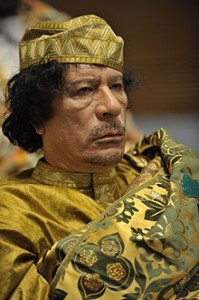
Slain Libyan leader Muammar Gaddafi
Gaddafi also used Libya’s wealth to fund projects to give African countries more control of their own natural resources, like a Libyan-funded factory in Liberia to manufacture and export tire grade rubber instead of raw rubber. He also co-founded the African Union in 2002, which he envisioned growing into a military alliance and a common market with a single currency.
Militant Islamists within the military tried but failed to assassinate Gaddafi in 1993. The Libyan Islamic Fighting Group (LIFG), formed by Libyans who had fought with CIA- and Saudi-backed forces in Afghanistan, was paid by the U.K.’s MI6 intelligence agency and Osama Bin-Laden to also try to kill him in 1996. The U.K. gave asylum to some of LIFG’s members, most of whom settled among the large Libyan community in Manchester.
The U.K. banned LIFG in 2005 and confiscated its members’ passports due to its links with Al Qaeda. But that all changed again in 2011, their passports were returned, and MI6 helped many of them travel back to Libya to join the “NATO rebels.” One LIFG member, Ramadan Abedi, took his 16-year old son Salman with him to Libya. Six years later, Salman struck his own blow for his family’s Islamist ideology, carrying out a suicide bombing that killed 23 young music fans at an Ariana Grande concert in Manchester in May 2017.
Western leaders’ eagerness to overthrow Gaddafi led France, the U.K., the U.S. and their NATO and Arab royalist allies to exploit a UN Security Council Resolution that authorized the use of force to protect civilians in Libya to overthrow the government, rejecting an African Union initiative to resolve the crisis peacefully.
The UN resolution called for an “immediate ceasefire” in Libya, but also authorized a “no-fly zone,” which became a pretext for bombing Libya’s military and civilian infrastructure with 7,700 bombs and missiles, and secretly deploying CIA officers and British, French and Qatari special operations forces to organize and lead Libyan rebel forces on the ground.
Qatar’s Chief of Staff, Major General Hamad bin Ali al-Atiya, told AFP, “We were among them and the numbers of Qataris on the ground were in the hundreds in every region. Training and communications had been in Qatari hands. Qatar… supervised the rebels’ plans because they are civilians and did not have enough military experience. We acted as the link between the rebels and NATO forces.” Qatari forces were even spotted leading the final assault on Libya’s Bab al-Aziziya military headquarters in Tripoli.
After taking Tripoli, NATO and its Libyan and Qatari allies cut off food, water and electricity to the people of Sirte and Bani Walid as they bombarded them for weeks. The combination of aerial, naval and artillery bombardment, starvation and thirst on these civilian populations made a final, savage mockery of UNSCR 1973’s mandate to protect civilians.
Once the U.S. and its allies had destroyed Libya’s government, they abandoned it to chaos and civil war that still rage on six years later. Two competing governments control different parts of the country, while local militias control many smaller areas. Since 2011, human rights groups have reported that thousands of black Libyans and sub-Saharan Africans have suffered arbitrary detention and appalling abuse at the hands of the Libyan militias that the U.S. and its allies helped to take over the country. News reports of Africans being sold in slave markets in Libya are only the latest outrage.
As Libya struggles to dig its way out of the endless chaos the U.S. and its allies plunged it into, the U.S. has more or less washed its hands of the crisis in Libya. In 2016, U.S. foreign aid to Libya was only $27 million.
Syria
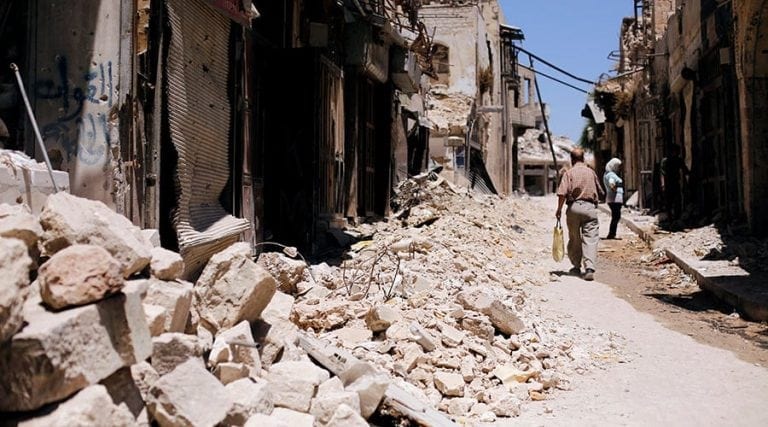
Death, blood, unspeakable suffering and rubble everywhere is the empire’s signature all over the world, especially now in the Middle East, which has seen its ancient societies and precious treasures blown to bits by the military of the most callous and ignorant nation in modern history.
[dropcap]T[/dropcap]he U.S. role in the civil war in Syria is a case study in how a CIA covert operation can fuel a conflict and destabilize a country to create pretexts for U.S. military intervention. The CIA began organizing the transport of fighters and weapons from Libya to Turkey in late 2011, as Turkey, Saudi Arabia and Qatar were militarizing an uprising in Syria that grew out of Arab Spring protests earlier in the year. British and French special operations forces provided military training in Turkey, and the CIA managed the infiltration of fighters and the distribution of weapons across the Syrian border.
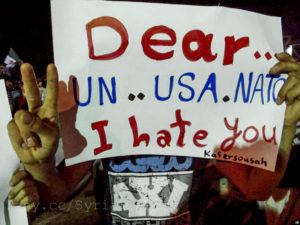
A protest placard in the Kafersousah neighborhood of Damascus, Syria, on Dec. 26, 2012. (Photo credit: Freedom House Flickr)
The Syrian government’s repression contributed to the transition from peaceful protests to an armed uprising. But the primarily leftist groups that organized the political protests in 2011 were committed to opposing violence, sectarianism and foreign intervention. They have always blamed Syria’s descent into war mainly on the foreign powers who supported the small Syrian Muslim Brotherhood and funneled more extreme foreign-based Islamist forces and thousands of tons of weapons into the country to ignite a full-scale civil war.
In 2012, as Kofi Annan tried to negotiate a ceasefire and a political transition in Syria, the U.S. and its allies poured in foreign fighters and heavier weapons and pledged even greater support to rebel forces at three Orwellian “Friends of Syria” conferences. One of these was timed to coincide with the date when Annan’s ceasefire was to take effect, and their new pledges of weapons, money and support for the rebels were a flagrant move to undermine the ceasefire.
After Annan eventually got all sides to agree on a peace plan in Geneva on June 30th 2012, on the understanding that it would then be codified in a UN Security Council Resolution, the U.S. and its allies went back to New York and inserted new conditions and triggers for sanctions and military action in the resolution, leading to a Russian veto. Annan’s Geneva Communique has been eclipsed by 5 more years of war and equally fruitless Geneva II, Geneva III and Geneva IV peace conferences.

Joint Special Envoy Kofi Annan spoke with the media at the United Nations Office at Geneva following the June 30, 2012 Meeting of the Action Group for Syria.
Annan quit a month later and was characteristically guarded in his public statements. But UN officials told the Atlantic in 2013 that Annan blamed the U.S. government for the failure of his mission. “The U.S. couldn’t even stand by an agreement that the Secretary of State had signed in Geneva,” said one of Annan’s closest aides. “He quit in frustration.”
After shipping at least 2,750 tons of weapons from Libya to Turkey in 2011 and 2012, including howitzers, RPGs and sniper rifles, the CIA began scouring the Balkans for weapons left over from the wars in the 1990s that the Saudis and Qataris could buy to flood into Syria through Turkey and Jordan. They shipped in up to 8,000 tons of weapons on flights from Croatia by March 2013.
Since then, the Saudis have bought more weapons from 8 different Balkan countries, as well as 15,000 TOW anti-tank missiles directly from the U.S. for $1.1 billion in December 2013. That was despite U.S. officials admitting as early as October 2012 that most of the weapons shipped into Syria had gone to “hardline Islamic jihadists.” Investigators in the Balkans report that the Saudis made their largest purchases ever in 2015, including brand new weapons straight off the production line. Only 60% of these weapons had been delivered by early 2017, meaning that the flood of weapons will continue as long as the CIA keeps facilitating it and U.S. allies like Turkey and Jordan keep acting as conduits.
The main innovation in U.S. war-making under the Obama administration was a doctrine of covert and proxy war that avoided heavy U.S. casualties at the expense of a reliance on aerial bombardment, drone killings, a huge expansion of deadly special forces operations and the use of foreign proxy forces. In every case, this fueled the global explosion of violence and chaos unleashed by Bush, and the main victims were millions of innocent civilians in country after country.
U.S. support for Al Qaeda splinter groups like Jabhat al-Nusra (now rebranded Jabhat Fateh al-Sham) and Islamic State turned the U.S. “war on terror” on its head. Only ten years after September 11th, the U.S. was ready to support these groups to destabilize Libya and Syria, where the CIA was looking for pretexts for war and regime change. The U.S. only reverted to its “war on terror” narrative after U.S. and allied support had built up these groups to the point that they could invade Iraq and take over its second largest city and a large swath of the country.
The U.S. covert proxy war in Syria led to the heaviest U.S. bombing campaign since Vietnam, which has reduced several cities in Iraq and Syria to rubble and killed tens of thousands of civilians; a civil war in Syria that has killed hundreds of thousands of Syrians; and a refugee crisis that has overwhelmed U.S. allies in the Middle East and Europe. After 6 years of war, Syria remains fragmented and mired in chaos. The Syrian government has regained control of many areas, but the future remains very dangerous and uncertain for the people of Syria. The U.S. currently has at least 1,723 troops on the ground in Syria, without any legal basis to be there, as well as 2,730 in Jordan and 2,273 in Turkey.
Ukraine
[dropcap]P[/dropcap]resident Yanukovych of Ukraine was overthrown in a violent coup in February 2014. Originally peaceful protests in the Maidan, or central square, in Kiev had gradually become dominated by the extreme right-wing Svoboda Party and, since November 2013, by a shadowy new group called Right Sector. These groups displayed Nazi symbols, fought with police and eventually invaded the Ukrainian parliament building, prompting Yanukovych to flee the country.
On February 4th, 2014, leaked audio of a conversation between U.S. Ambassador Geoffrey Pyatt and Assistant Secretary of State Victoria Nuland revealed U.S. plans for a coup to remove Yanukovych and install U.S. favorite Arseniy Yatsenyuk as Prime Minister. Nuland and Pyatt used language like, “glue this thing,” “midwife this thing” and “we could land jelly side up on this thing if we move fast,” as well as the more widely reported “Fuck the EU,” who they didn’t expect to support their plan.
On February 18th, Right Sector led 20,000 protesters on a march to the parliament building. They attacked police with Molotov cocktails, stormed and occupied government buildings and the police and attacked the protest camp in the Maidan. As running battles with the police continued over the next few days, an estimated 75 people were killed, including 10 police and soldiers. Mysterious snipers were reported firing from Philharmonic Hall and a hotel overlooking the Maidan, shooting at police and protesters.
Yanukovych and his government held meetings with opposition leaders, and the EU sent the foreign ministers of France, Germany and Poland to mediate the crisis. On February 21st, Yanukovych agreed to hold new presidential and parliamentary elections before the end of the year.
But the protesters, now led by Svoboda and Right Sector, were not satisfied and took over the parliament building. Right Sector had broken into an armory in Lviv and seized assault rifles and pistols, and the police no longer resisted. On February 22nd, the parliament failed to make a quorum (338 of 447 members), but the 328 members present voted to remove Yanukovych from office and hold a new election in May. Yanukovych issued defiant statements and refused to resign, then fled to Russia.
Russian-speaking parts of Ukraine refused to accept the results of the coup. The Crimean parliament organized a referendum, in which 97% voted to leave Ukraine and rejoin Russia, which Crimea had been part of since 1783. As an administrative matter, Kruschev had placed Crimea within the Ukrainian SSR in the 1950s, but when the USSR broke up, 94% of Crimeans voted to become an autonomous republic and 83% voted to keep dual Russian and Ukrainian citizenship.
Russia accepted the result of the referendum and now governs Crimea. The greatest dangers to Russia from the coup in Kiev were that Ukraine would join NATO and Russia would lose its most strategic naval base at Sevastopol on the Black Sea. NATO issued a declaration in 2008 that Ukraine and Georgia “will become members of NATO.” Also in 2008, Ukraine threatened not to renew the lease on the base at Sevastopol, which was due to expire in 2017, but it was eventually extended to 2042.
The UN has not recognized Russia’s reintegration of Crimea, and the U.S. has called it a violation of international law. But given the history and autonomous status of Crimea, and the importance of Sevastopol to Russia, it was an understandable and predictable response to the illegal U.S.-planned coup in Ukraine. It is the height of hypocrisy for U.S. officials to suddenly pose as champions of international law, which U.S. policy has systematically ignored, violated and undermined since the 1980s. (Actually well over a century. The only change has been in style, with the empire becoming ever bolder and shameless in its depredations given its enjoyment of almost total impunity.—Editor.)
Russian-speaking majorities in Eastern Ukraine also declared independence from Ukraine as the People’s Republics of Donetsk and Luhansk and appealed for Russian support, which Russia has covertly provided, although the extent of it is hotly debated. There were also large protests against the coup in Odessa on the Black Sea, and 42 protesters were killed when a Right Sector mob attacked them and set fire to the Trades Union building where they took refuge.
With the Ukrainian military unable or unwilling to launch a civil war against its Russian-speaking compatriots in the East, the post-coup government recruited and trained a new “National Guard” to do so. It was soon reported that the Azov Battalion and other National Guard units were linked to Svoboda and Right Sector, and that they were still displaying Nazi symbols as they assaulted Russian-speaking areas in Eastern Ukraine. In 2015, the Azov Battalion was expanded to a 1,000-strong Special Operations Regiment.
The civil war in Ukraine has killed more than 10,000 people. The Minsk agreements between Ukraine, Russia, France and Germany in September 2014 and February 2015 established a tenuous ceasefire and withdrawal of heavy weapons by both sides, but the political problems persist, fueling outbreaks of fighting. The U.S. has now agreed to send Ukraine Javelin anti-tank missiles and other heavier weapons, which are likely to reignite heavier fighting and complicate political negotiations.
Giving Peace a Chance?
[dropcap]G[/dropcap]iving war a chance has not worked out well, to put it mildly, in Afghanistan, Iraq, Somalia, Honduras, Yemen, Libya, Syria or Ukraine. All remain mired in violence and chaos caused by U.S. invasions, bombing campaigns, coups and covert operations. In every case, U.S. policy decisions have either made these countries’ problems worse or are entirely responsible for the incredible problems afflicting them. Many of those decisions were illegal or criminal under U.S. and/or international law. The human cost to millions of innocent people is a historic tragedy that shames us all. In every case, the U.S. could have made different decisions, and in every case, the U.S. can still make different decisions.
As an American general once observed, “When the only tool you’ve got is a hammer, every problem looks like a nail.” The allocation of most of our federal budget to military spending both deprives the U.S. of other “tools” and creates political pressures to use the one we have already paid so much for, as implied in Albright’s question to Powell in 1992.
In Mr. Trump’s new national security strategy, he promised Americans that he will “preserve peace through strength.” But the U.S. is not at peace today. It is a nation at war across the world. The U.S. has 291,000 troops stationed in 183 foreign countries, amounting to a global military occupation. It has deployed special operations troops on secret combat and training missions to 149 countries in 2017 alone. It has dropped 39,000 bombs and missiles on Iraq, Syria and Afghanistan since Trump took office, and the U.S.- and Iraqi-led assault on Mosul alone killed an estimated 40,000 civilians. Pretending we are at peace and vowing to preserve it by diverting more of our resources to the military industrial complex is not a national security strategy. It is an Orwellian deception taken straight from the pages of 1984.
At the dawn of 2018, nobody could accuse the American public of not giving war a chance. We have let successive presidents talk us into war over each and every international crisis, most of which were caused or fueled by U.S. aggression and militarism in the first place, in the belief that they may have finally found an enemy they can defeat and a war that will somehow make life better for somebody somewhere. But they haven’t.
As we look forward to a new year, surely it is time to try something different and finally “Give Peace a Chance.” My 15-year old self was willing to spend Christmas fasting on the cold steps of a church to do that in 1969. What can you do to give peace a chance in 2018?

 Stephen Lendman was born in 1934 in Boston, MA. In 1956, he received a BA from Harvard University. Two years of US Army service followed, then an MBA from the Wharton School at the University of Pennsylvania in 1960. After working seven years as a marketing research analyst, he joined the Lendman Group family business in 1967. He remained there until retiring at year end 1999. Writing on major world and national issues began in summer 2005. In early 2007, radio hosting followed. Lendman now hosts the Progressive Radio News Hour on the Progressive Radio Network three times weekly. Distinguished guests are featured. Listen live or archived. Major world and national issues are discussed. Lendman is a 2008 Project Censored winner and 2011 Mexican Journalists Club international journalism award recipient.
Stephen Lendman was born in 1934 in Boston, MA. In 1956, he received a BA from Harvard University. Two years of US Army service followed, then an MBA from the Wharton School at the University of Pennsylvania in 1960. After working seven years as a marketing research analyst, he joined the Lendman Group family business in 1967. He remained there until retiring at year end 1999. Writing on major world and national issues began in summer 2005. In early 2007, radio hosting followed. Lendman now hosts the Progressive Radio News Hour on the Progressive Radio Network three times weekly. Distinguished guests are featured. Listen live or archived. Major world and national issues are discussed. Lendman is a 2008 Project Censored winner and 2011 Mexican Journalists Club international journalism award recipient. 
